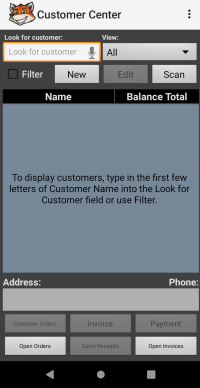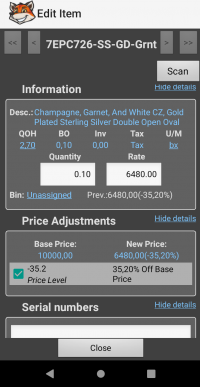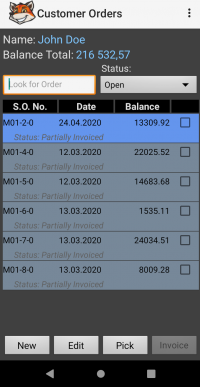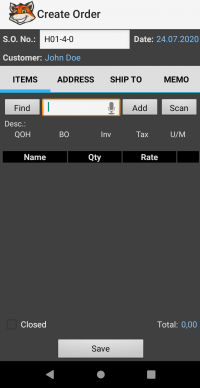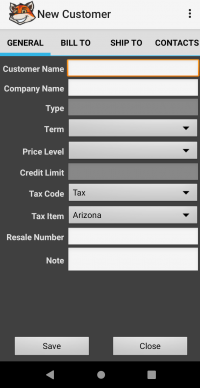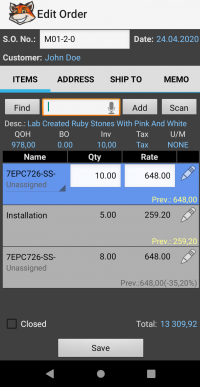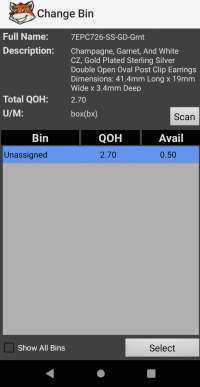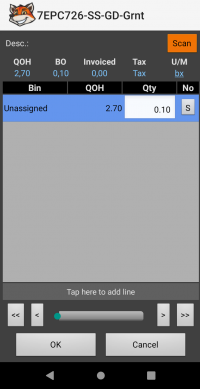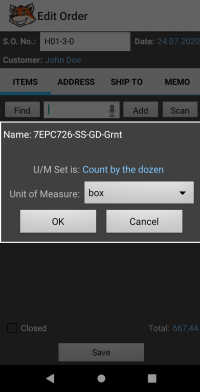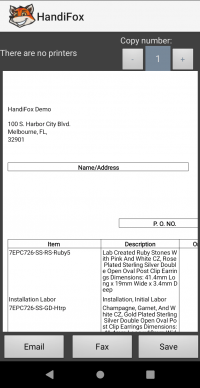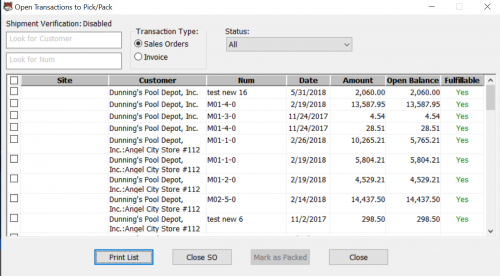Difference between revisions of "Sales Orders"
Jump to navigation
Jump to search
Hermosillo.c (talk | contribs) |
Hermosillo.c (talk | contribs) |
||
| Line 262: | Line 262: | ||
=Closing Sales Orders= | =Closing Sales Orders= | ||
| − | #On the app, go to Main → Sales. | + | #On the app, go to ''Main → Sales''. |
#Fill the name of customer you want to close sales order for and choose it in the list. | #Fill the name of customer you want to close sales order for and choose it in the list. | ||
#Tap '''Customer Orders''' button and choose any sales order you need to close. | #Tap '''Customer Orders''' button and choose any sales order you need to close. | ||
Revision as of 17:22, 24 September 2020
HandiFox allows users to create Sales Orders, orders issued to customers and specified items or services including their price, quantities, terms and conditions.
Contents
Sales Order Screen
- Look for customer field: It allows looking for customer you want to work with sales order for.
- View drop-down menu: It allows watching active or all the transactions.
- Filter checkbox: It allows creating filters to look for customers according to specific features.
- Look for field: It allows entering the information which helps to find the customer
- In drop-down menu: It allows choosing section in which filled in information is
- Back button: It allows leave Filter screen without saving changes
- Apply button: It allows applying filters set.
- New button: It allows creating new customer.
- Edit button: It allows editing created customers.
- Scan button: It allows looking for transactions with the help of scanner
- Customer Orders button: It allows making different actions with sales orders like creating new on, edit, pick or invoice it.
- Look for Order field: It allows entering the number of sales order which helps to find it
- Status drop-down menu: It allows looking for sales orders according to their status
- New button: It allows creating new sales order.
- Edit button: It allows editing existing sales orders.
- Pick button: It allows picking sales orders.
- Invoice button: It allows invoicing sales orders.
- Open Orders button: It allows making different actions with open sales orders like editing and picking.
- Look for customer field: It allows entering the name of customer which helps to find it
- Filter checkbox: It allows creating filters to look for customers according to specific features.
- Look for field: It allows entering the information which helps to find the customer
- In drop-down box: It allows choosing section in which filled in information is
- Back button: It allows leave Filter screen without saving changes
- Apply button: It allows applying filters set.
- Scan button: It allows looking for transactions with the help of scanner
- Look for Order field: It allows entering the number of sales order which helps to find it
- Status drop-down menu: It allows looking for sales orders according to their status
- Edit button: It allows editing existing sales orders.
- Pick button: It allows picking sales orders.
Edit Item Screen
- Scan button: this button allows looking for items using scanner
- QOH: shows the number of units that are physically located in the warehouse at the current time.
- BO: shows the number of backordered items.
- Inv: shows item's invoice status.
- Tax: shows tax rate.
- U/M: shows unit of measure type.
- Quantity field: shows item quantity.
- Rate field: shows item rate.
- Bin: shows bin status for item (assigned/unassigned).
- Prev.: shows the previous rate.
- Hide Details button: this button allows hiding the details about item in the screen.
- Base Price: shows base price before price level applying.
- New Price: shows new price after price level applying.
- Serial Numbers field: allows assgning seral numbers to the item.
Creating Sales Orders
HandiFox allows creating sales orders in the app and send it to QuickBooks.
- On the app, go to Main → Sales.
- Fill the name of customer you want create sales order for and choose it in the list.
- Tap Customer Orders button and tap New to create sales order.
- Tap Find button and choose all the items you want to create sales order for.
- Tap Add button.
- Fill Qty and Rate columns with data if it is needed.
- Tap Save button.

To apply Price Rules and Volume Discounts to Sales Orders, please see Applying Volume Discounts and Price Rules on Handheld Device).
Note
The information string above the grid gives the information about the item choosed:
*Description – sales description
*U/M – unit of measure abbreviation ("NONE" is shown if U/M Set is not defined). The user is able to change the U/M by long-tapping on the U/M field. Qty and Rate values for the item will be recalculated based on the selected unit of measure.
! If handheld synchronizes for the first time after HandiFox initialization and downloads the Sales Order and unit of measure's conversion ratio is changed for a Sales Order's item in QuickBooks then “[NONE]” is shown as unit of measure. If handheld synchronizes for the first time after HandiFox initialization and downloads the Sales Order and unit of measure set is changed for a Sales Order's item in QuickBooks then unit of measure’s abbreviation is shown in brackets. If Sales Order is already present on the handheld and unit of measure set or unit of measure's name, abbreviation or conversion ratio are changed for a Sales Order's item in QuickBooks then unit of measure name is shown in brackets.
To change Unit Of Measure for items in Sales Orders, open Sales Order, tap Edit button and tap U/M data. Use drop-down menu to choose Unit of Measure and tap OK button.
*BO – backordered quantity (difference between ordered quantity and invoiced quantity, equals to 0 if ordered quantity is less than invoiced quantity). If sales order and linked invoice are created in QuickBooks, then after editing the invoice on the handheld, backordered quantity is not changed. *Invoiced – invoiced quantity. If sales order and linked invoice are created in QuickBooks, then after editing the invoice on the handheld, invoiced quantity is not changed. Total field, shown at the bottom of the Items page, is calculated based on the order items’ Qty, Rate and taxes.
Customer Center
Edit Customer
- Create New Customer: On the app, go to Menu → Sales → New
- Edit Customer: On the app, go to Menu→Sales
- General tab consists of following fields: Customer Name, Company Name, Type, Term, Price Level, Credit Limit, Release Number, Note.
- Bill to tab (customer’s billing address information) consists of following fields: Address, City, State, Zip, Country, Note.
- Ship to tab (customer’s shipping information) consists of following fields: Address, City, State, Zip, Country, Note.
- Contacts tab (customer’s contact information) consists of following fields: Mr./Ms./…, First Name, M.I., Last Name, Contact, Phone, Fax, Alt. Phone, Alt. Contact, E-mail.
Edit Job
- Create New Job: On the app, go to Menu → Sales. Type the name of the customer, tap on it and choose Add Job.
- General tab consists of following fields: Job Name, Customer, Company Name, Type, Price Level, Credit Limit, Note.
- Bill to tab (customer’s billing address information) consists of following fields: Address, City, State, Zip, Country, Note.
- Ship to tab (customer’s shipping information) consists of following fields: Address, City, State, Zip, Country, Note.
- Contacts tab (customer’s contact information) consists of following fields: Mr./Ms./…, First Name, M.I., Last Name, Contact, Phone, Fax, Alt. Phone, Alt. Contact, E-mail.
Reviewing and Editing Sales Orders
HandiFox allows editing sales orders on the handheld device.
- In the app, go to Main → Sales.
- Fill the name of customer you want create sales order for and choose it in the list.
- Tap Customer Orders button and tap Edit to create sales order.
- Make all the changes needed. Edit Qty and Rate columns with data or add new items by tapping Find and End button
- Tap Save button.
![]() HandiFox only allows editing open orders.
HandiFox only allows editing open orders.
Item Location Every item on the order can get a bin location where the items will be taken from. You can change that location if necessary. 1.Make a long tap on the item and select Change Bin option. 2.Open the full list of bins by checking the Show All Bins checkbox. 3.Highlight desired bin and tap Select.
You can select multiple bins and specify a quantity for each of them separately. 1.Make a long tap on the item and select Edit. 2.Define item quantities per bin location (use the link at the bottom to add bins on the list).
Applying Price Level To apply a price level to an item perform the long tap on it and select Apply Price Level entry from the pop-up menu. ! The “Apply Price Level” entry is disabled if there is no Price Levels associated with this item. The Price Level dropdown list is filled with price levels: - Base Sales Price - All Fixed % - price levels configured in the system - “Per Item” - price levels where item's custom price is defined Current Rate field shows current item's rate. New Rate field shows item's rate after applying price level. ! Only active price levels are displayed in Select Price Level
To remove price rules, go to Main → Sales, type customer name in Look for customer field, tap Customers/Open Orders. Choose any Order consisting of items you want remove price rules for. Tap Edit button, tap Pencil button and uncheck Price Level checkbox in Price Adjustments field.
Pick/Pack Sales Orders You can pick/pack items tapping on Pick or Pack button in Customer Orders screen (see.).
Select Unit of Measure
The user is able to select a unit of measure from unit of measure set assigned to the inventory item.
Qty and Rate values are recalculated based on the selected unit of measure.
When the screen opens, the U/M, currently selected for the item, is highlighted.
The following information is shown:
•U/M Set Name
•Base Unit
oName
oAbbreviation
Printing and Emailing Existing Sales Orders
You can print Sales Orders from the device in case it has ability to print documents. (?)
- In the app, go to Main → Sales.
- Fill the name of customer you want print sales order for and choose it in the list.
- Tap Customer Orders button and then tap Menu button in the right up corner of the screen.
- Tap Print button and choose the number of copies you need.
- Choose printer in the left top corner and tap Print Sales Order.
or
- In the app, go to Main → Sales.
- Fill the name of customer you want print sales order for and choose it in the list.
- Tap Open Orders button and then tap Menu button in the right up corner of the screen.
- Tap Print button and choose the number of copies you need.
- Choose printer in the left top corner and print Sales Order.
You can send Sales Order via email from the app on your device.
- In the app, go to Main → Sales.
- Fill the name of customer you want print sales order for and choose it in the list.
- Tap Customer Orders button and then tap Menu button in the right up corner of the screen.
- Tap Print button and tap Email button.
- Fill Email field with adress you want send Sales Order to, fill Subj field and empty field if it's needed. Tap Send buttton to send email.
or
- In the app, go to Main → Sales.
- Fill the name of customer you want print sales order for and choose it in the list.
- Tap Open Orders button and then tap Menu button in the right up corner of the screen.
- Tap Print button and tap Email button.
- Fill Email field with adress you want send Sales Order to, fill Subj field and empty field if it's needed. Tap Send buttton to send email.
Cloning Sales Orders
HandiFox allow users to clone open sales orders for different needs.
- In the mobile app, go to Main → Sales.
- Fill the name of customer you want create or edit sales order for and choose it in the list.
- Tap Open Orders button and long tap it.
- Tap Clone Sales Order.
- Change the data in the screen if it is needed and tap Save.
or
- In the mobile app, go to Main → Sales.
- Fill the name of customer you want create or edit sales order for and choose it in the list.
- Tap Customer Orders button and long tap it.
- Tap Clone Sales Order.
- Change the data in the screen if it is needed and tap Save.
Printing Sales Orders
HandiFox allows users to print Sales Orders on the desktop.
- In QuickBooks, go to File → HandiFox → Open Transactions to Pick/Pack.
- Choose Sales Order in Transaction Type.
- Check any sales order in the list.
- Tap Print List and tap OK on the Print screen.
Saving Sales Orders Report
- In QuickBooks, go to File → HandiFox → Open Transactions to Pick/Pack.
- Choose Sales Order in Transaction Type.
- Check any Sales Order in the list.
- Click Print List.
- Check Print to File checkbox and click OK.
- Choose folder you want your report save to and click OK.
Closing Sales Orders
- On the app, go to Main → Sales.
- Fill the name of customer you want to close sales order for and choose it in the list.
- Tap Customer Orders button and choose any sales order you need to close.
- Tap Edit button and check Closed checkbox.
- Tap Save.
or
- In QuickBooks, go to File → HandiFox → Open Transactions to Pick/Pack.
- Choose Sales Order in Transaction Type.
- Click Close SO and click Yes.
Invoicing Sales Orders
- On the app, go to Main → Sales.
- Fill the name of customer you want to invoice sales order for and choose it in the list.
- Tap Customer Orders button and choose any sales order you need to invoice via checking it.
- Tap Invoice button then tap Save.
- Fill in your name in Customer Name field and tap Enter Sign.
- Sign in the white box appeared and tap OK.
- Tap Save.
